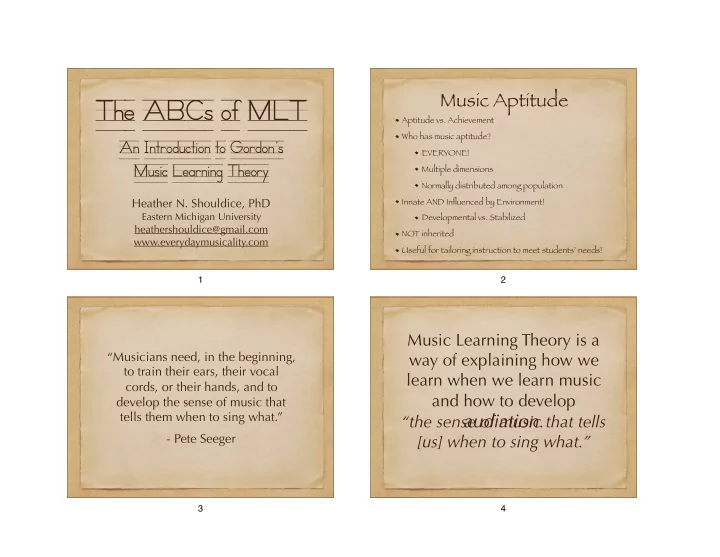

Music Aptitude The ABCs of MLT Aptitude vs. Achievement Who has music aptitude? An Introduction to Gordon’s EVERYONE! Music Learning Theory Multiple dimensions Normally distributed among population Heather N. Shouldice, PhD Innate AND Influenced by Environment! Eastern Michigan University Developmental vs. Stabilized heathershouldice@gmail.com NOT inherited www.everydaymusicality.com Useful for tailoring instruction to meet students’ needs! 1 2 Music Learning Theory is a “Musicians need, in the beginning, way of explaining how we to train their ears, their vocal learn when we learn music cords, or their hands, and to and how to develop develop the sense of music that tells them when to sing what.” audiation. “the sense of music that tells - Pete Seeger [us] when to sing what.” 3 4
Audiation... The primary goal of - means the hearing and comprehension of music in the mind. Music Learning Theory - involves a sense of tonal/rhythm syntax. is to enhance musical - is the ability to think in musical sound. understanding and skills - involves prediction. through the development of audiation. 1 4 3 2 5 6 How can I start helping my Sequential Learning students develop audiation? Resting tone: model, sing, play, find! Language “Vocabularies” Music “Vocabularies” Basic harmony: 1. Listening 1. Listening Resting tone drone/ostinato 2. Speaking 2. Singing/Chanting/Moving/Playing Chord roots (i.e., basslines) 3. Thinking/Conversing 3. Audiating/Improvising “Research to Real Life” blog 4. Reading 4. Reading www.everydaymusicality.com 5. Writing 5. Writing Chord tones in 3 parts Macrobeat/microbeat: move/chant Each beat level separately, then simultaneously 7 8
Skill Learning Sequence… Skill Learning Sequence Discrimination Learning Inference Learning Content vs. Skills Aural/Oral Generalization Verbal Association Aural/Oral-Verbal-Symbolic (Nouns) (Verbs) Reading-Writing Partial Synthesis Creativity/Improvisation Tonal Patterns Singing Symbolic Association Aural/Oral-Verbal-Symbolic Rhythm Patterns Chanting Reading-Writing Reading-Writing Theoretical Understanding Composite Synthesis Pattern Function Reading/Writing Reading-Writing Resting Tone Creating/Improvising Macrobeat/Microbeat Labeling 9 10 Want to know more? Gordon Institute for Music Learning www.giml.org 2019 GIML International Conference July 30-August 1 in Chicago (Oak Park) Alliance for Active Music Making www.allianceamm.org GIA Publications www.giamusic.com Resources on my website… www.everydaymusicality.com 11
Recommend
More recommend